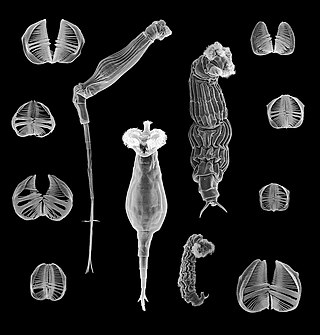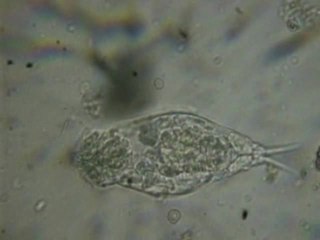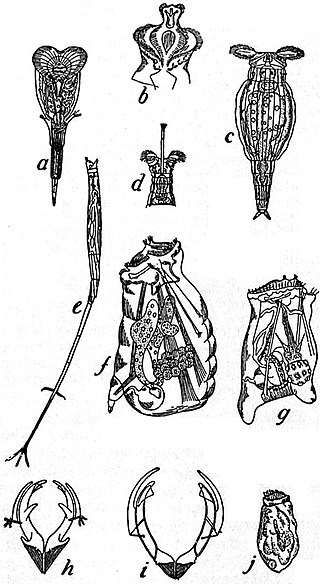
Asexual reproduction is a type of reproduction that does not involve the fusion of gametes or change in the number of chromosomes. The offspring that arise by asexual reproduction from either unicellular or multicellular organisms inherit the full set of genes of their single parent and thus the newly created individual is genetically and physically similar to the parent or an exact clone of the parent. Asexual reproduction is the primary form of reproduction for single-celled organisms such as archaea and bacteria. Many eukaryotic organisms including plants, animals, and fungi can also reproduce asexually. In vertebrates, the most common form of asexual reproduction is parthenogenesis, which is typically used as an alternative to sexual reproduction in times when reproductive opportunities are limited. Komodo dragons and some monitor lizards can reproduce asexually.

Acanthocephala is a group of parasitic worms known as acanthocephalans, thorny-headed worms, or spiny-headed worms, characterized by the presence of an eversible proboscis, armed with spines, which it uses to pierce and hold the gut wall of its host. Acanthocephalans have complex life cycles, involving at least two hosts, which may include invertebrates, fish, amphibians, birds, and mammals. About 1420 species have been described.

The rotifers, commonly called wheel animals or wheel animalcules, make up a phylum of microscopic and near-microscopic pseudocoelomate animals.

Bdelloidea is a class of rotifers found in freshwater habitats all over the world. There are over 450 described species of bdelloid rotifers, distinguished from each other mainly on the basis of morphology. The main characteristics that distinguish bdelloids from related groups of rotifers are exclusively parthenogenetic reproduction and the ability to survive in dry, harsh environments by entering a state of desiccation-induced dormancy (anhydrobiosis) at any life stage. They are often referred to as "ancient asexuals" due to their unique asexual history that spans back to over 25 million years ago through fossil evidence. Bdelloid rotifers are microscopic organisms, typically between 150 and 700 µm in length. Most are slightly too small to be seen with the naked eye, but appear as tiny white dots through even a weak hand lens, especially in bright light. In June 2021, biologists reported the restoration of bdelloid rotifers after being frozen for 24,000 years in the Siberian permafrost.
Seisonidae is a family of rotifers, found on the gills of Nebalia, a marine crustacean. Peculiar among rotifers, males and females are both present and equal in size. Males and females are similar with paired gonads. It is considered to have diverged from the other rotifers early on, and in one treatment is placed in a separate class Seisonoidea. They have a large and elongate body with reduced corona. Their muscular system is similar to that of other rotifers: they have longitudinal muscles as well as open annular muscles.

The family Argulidae, whose members are commonly known as carp lice or fish lice, are parasitic crustaceans in the class Ichthyostraca. It is the only family in the monotypic subclass Branchiura and the order Arguloida, although a second family, Dipteropeltidae, has been proposed. Although they are thought to be primitive forms, they have no fossil record.
A cercaria is the larval form of the trematode class of parasites. It develops within the germinal cells of the sporocyst or redia. A cercaria has a tapering head with large penetration glands. It may or may not have a long swimming "tail", depending on the species. The motile cercaria finds and settles in a host where it will become either an adult, or a mesocercaria, or a metacercaria, according to species.

Brachionus is a genus of planktonic rotifers occurring in freshwater, alkaline and brackish water.

Syndermata is a clade of animals that, in some systems, is considered synonymous with Rotifera. Older systems separate Rotifera and Acanthocephala as different phyla, and group them both under Syndermata. This clade is placed in the Platyzoa.

Brachionus calyciflorus is a planktonic rotifer species occurring in freshwater. It is commonly used as a model organism in toxicology, ecology and evolutionary biology.
Its advantages include the small size and short generation time.

Keratella cochlearis is a rotifer. The planktonic animal occurs worldwide in freshwater and marine habitats.

Ploima is an order of rotifers, microscopic invertebrates found in marine and freshwater habitats.
Adineta ricciae is a species of freshwater rotifers in the family Adinetidae. It was first described in 2005 after being discovered by chance in dry mud beside a billabong in Australia. It is used as a model organism as it is easy to keep in culture.

Synchaeta is a genus of rotifers belonging to the family Synchaetidae.

Cephalodella is a genus of rotifers in the family Notommatidae.
Ascomorpha is a genus of rotifers belonging to the family Gastropodidae.
Gastropodidae is a family of rotifers belonging to the order Ploima.

Brachionidae is a family of rotifers belonging to the order Ploima. Species are found in freshwater and marine habitats.
Collothecaceae is an order of rotifers belonging to the class Monogononta.

Asplanchna brightwellii are a species of rotifer from the genus Asplanchna. They are known to inhabit eutrophic water. The sac-like freshwater rotifier is known to eat cladocerans, protozoans, and other rotifers. A. brightwelli are relatively large for rotifiers, transparent and ovoviviparous which makes the species ideal for morphological studies.











